flipkart
PS5 Restock India: PlayStation 5, PS5 Digital Edition Tipped to Be Available for Pre-Order on October 25
from Gadgets 360 https://ift.tt/3BWxs1l
Xiaomi Redmi Note 11, Note 11 Pro price, specifications leak ahead of launch: All you need to know
The Redmi Note series is one of Xiaomi's best-selling phone line-ups and now it appears the company is reportedly looking to bring new phones to the series in the near future. As per a new leak, the phones could be launched soon, with pricing details of the devices being leaked already. The leak suggests there will be two devices in the Redmi Note 11 series, with the Redmi Note 11 Pro tipped to be powered by the MediaTek Dimensity 920 SoC, while, the Redmi Note 11 will be powered by the MediaTek Dimensity 810 SoC.
Redmi Note 11 series featuresComing courtesy of tipster Arsenal via Weibo, the leak reveals key information about the Redmi Note 11 and Redmi Note 11 Pro. The leak claims the Redmi Note 11 will be priced at CNY 1,199 (approx Rs 14,000) for the entry 6GB RAM + 128GB storage option and CNY 1,399 (approx Rs 16,000) for the 8GB RAM + 128GB storage version. There will also be a more expensive 8GB RAM + 256GB storage variant that will be available at a price of CNY 1,599 (approx Rs 19,000).
The Redmi Note 11 Pro is will be the more expensive of the two devices, and will be priced at CNY 1,599 (approx Rs. 19,000) for the entry variant with 6GB RAM + 128GB storage and CNY 1,799 (approx Rs 21,000) for the 8GB RAM + 128GB storage one. The top-end variant will reportedly retail for CNY 1,999 (pprox Rs 23,000) for the 8GB RAM + 256GB storage option.
Also Read: Airtel Xstream, JioFiber, BSNL offer a range of Monthly broadband plans under Rs 1500, check details
Redmi Note 11, Note 11 Pro: Expected specificationsThe leak also reveals some details about the two phones. As per the details shared by the tipster, the Redmi Note 11 will come with an LCD display that will support up to 120Hz refresh rate. Underneath, the phone will house a MediaTek Dimensity 810 SoC paired with up to 8GB RAM and up to 256GB storage. For cameras, the Redmi Note 11 will get a 50-megapixel rear camera and a 16-megapixel selfie camera. Powering the device will be a 5,000mAh battery pack with support for 33W fast charging.
Redmi Note 11 Pro on the other hand will feature more premium hardware, As such, it may get an OLED display with a 120Hz refresh rate. The chipset is tipped to be MediaTek Dimensity 920 SoC paired with up to 8GB RAM. For cameras, the Redmi Note 11 Pro will likely get a 108-megapixel rear camera and a 16-megapixel selfie camera. Again, powering the device will be a 5,000mAh battery pack with 67W fast charging support.
from Mobile Phones News https://ift.tt/3n4UuwJ
Suunto 7 Review: A true smartwatch experience for those who love the outdoors
The Suunto 7 is a pretty unique offering. Its WearOS base gives users the flexibility to access major apps that they can install on their wearable. Along with that, the legacy and expertise of Suunto give the watch a top-notch build that can rival any rugged watch in the market. As such, the Suunto 7 is arguably the most rugged device that can call itself a proper smartwatch.
However, not everything is perfect. The UI in the Suunto 7 is confusing at least. The relatively poor battery life is also a cause for concern for those planning to wear it for camping or long hikes.
The UI concerns as well as relatively poor battery life make it difficult to recommend to new users looking for a rugged new wearable. However, those who require ruggedness and don’t really need smart features might be better off with something like the Garmin Forerunner 55. Similarly, those looking for a fitness-centric device without much ruggedness might consider something like the Apple Watch SE or the Samsung Galaxy Watch 4 (review), both of which are considerably more affordable.
The Suunto 7 has the unique position of being one of the only smartwatches to feature this level of ruggedness. As such, it doesn’t really have much in terms of direct competition. However, if Suunto can streamline the UI and improve battery life, it has the potential to be among the best.
Suunto is a name synonymous with rugged, outdoorsy accessories that range from compass sports watches. The Suunto 7 that we have right here is a part of a range of ‘smart sport' watches by the company which aim to merge rugged sports watches with the functionality offered by a WearOS powered device. While we have rugged wearables, they are usually based on proprietary platforms. So they can be limited when it comes to functionality and versatility that an established wearable OS can offer With prices starting from Rs 36,999, is the Suunto 7 worth picking over other wearables? Let’s find out.
Suunto 7: Design and buildThe Suunto 7 packs a very hefty build, which is expected from sports watches. It packs a large metal body with soft silicone straps. However, the wearable is still relatively light. It packs a total of four buttons, which is quite a lot compared to most other wearables in the market, but it does add to the whole ‘outdoorsy’ look that Suunto seems to be going for. The bottom of the Suunto 7 is made of sturdy plastic and houses the optical heart rate sensor and the contact points for the charge.
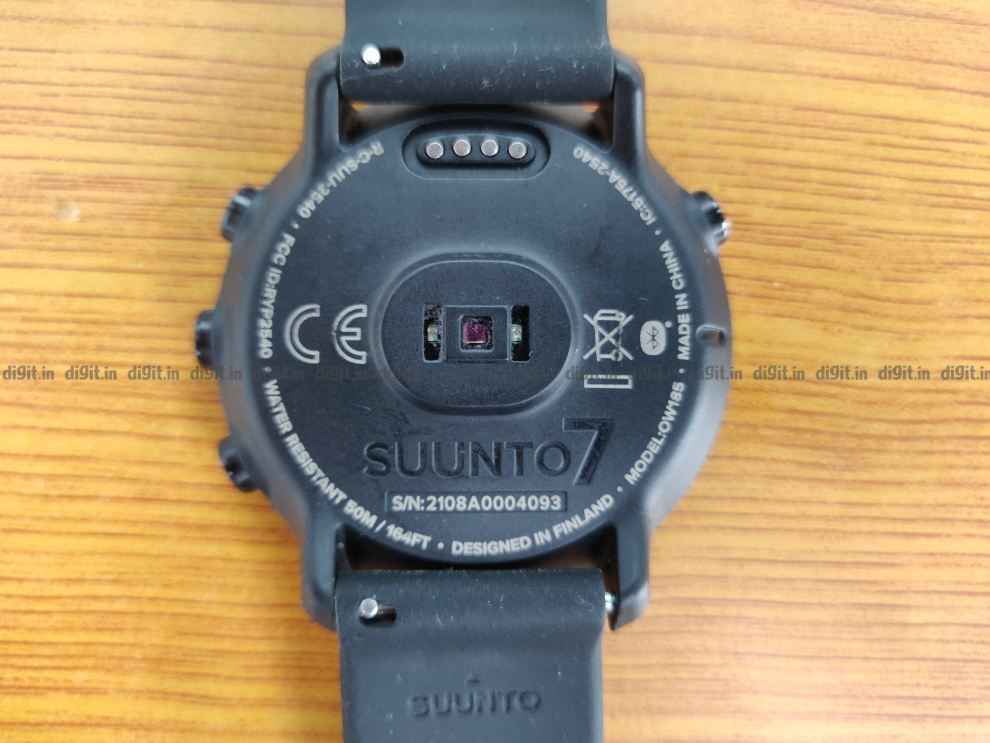
A notable little feature is that four edges around the display of the Suunto 7 are slightly raised. This helps protect the display when it is placed (or dropped) on the round. The display itself is made from Gorilla Glass which adds another degree of protection. Another handy thing to note is that the wearable is water-resistant up to 50m.
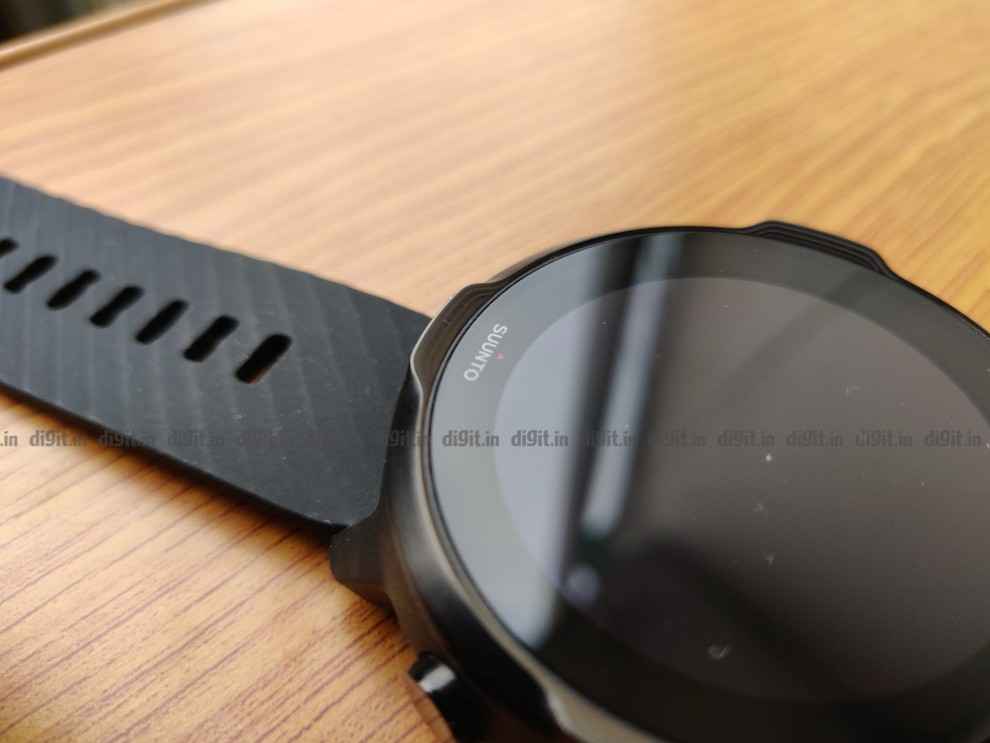
Despite its large size, the Suunto 7 is quite comfortable to wear. However, the large size does mean that those with smaller wrists might find it a little too ungainly.
Suunto 7: Display and UI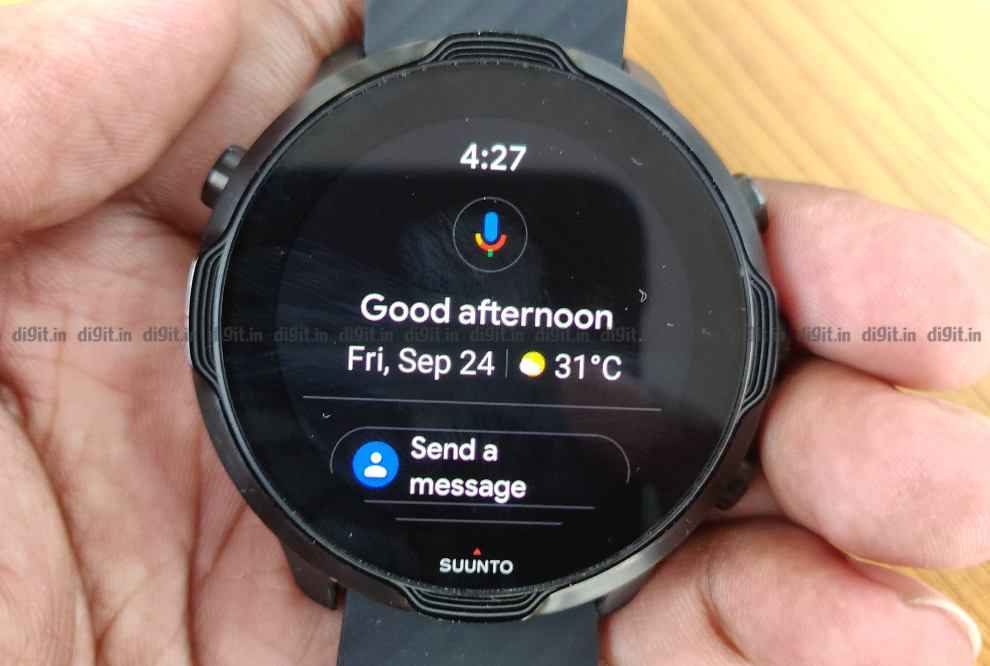
The Suunto 7 packs a large AMOLED colour touchscreen that is nice and vibrant, While the glass on the display is quite glossy, the display is bright enough to be legible in sunlight. It ticks all the right boxes. However, the same cannot be said about the UI…
Google’s WearOS powers the Suunto 7 and is fine for the most part. However, it does get annoying at times when trying to use it in tandem with Suunto’s own take on what the UI should be. The four buttons on the wearable tend to make things a little confusing too. For example, swiping right when inside a menu will take you back a step. But on the main menu, it will activate Google Assistant. The lone button on the left of the device acts as a ‘Home’ button most of the time. But when used on the home screen, it opens up Google’s list of apps.
Keep in mind that these apps are different to the tiles that one can access by swiping left on the watch face. The remaining three buttons on the right seem to be dedicated to activities. When on the watch face, the top button acts as a quick way to bring up the activity menu, the middle one brings up media controls, while the bottom button quickly brings up a stopwatch. When an activity is on, the top button will pause/resume activity, the bottom one will stop it. But pressing the bottom button without pausing the activity will set a marker such as a lap time. Are you still following me?
Overall, I’m sure anyone will get used to the setup after a few days of use. Further, the buttons do make it easier to use when wearing gloves or when underwater. But I still think that there could be more elegant ways of doing the same. Garmin and Fitbit seem to have nailed their UIs. Suunto will do well to take cues from them.
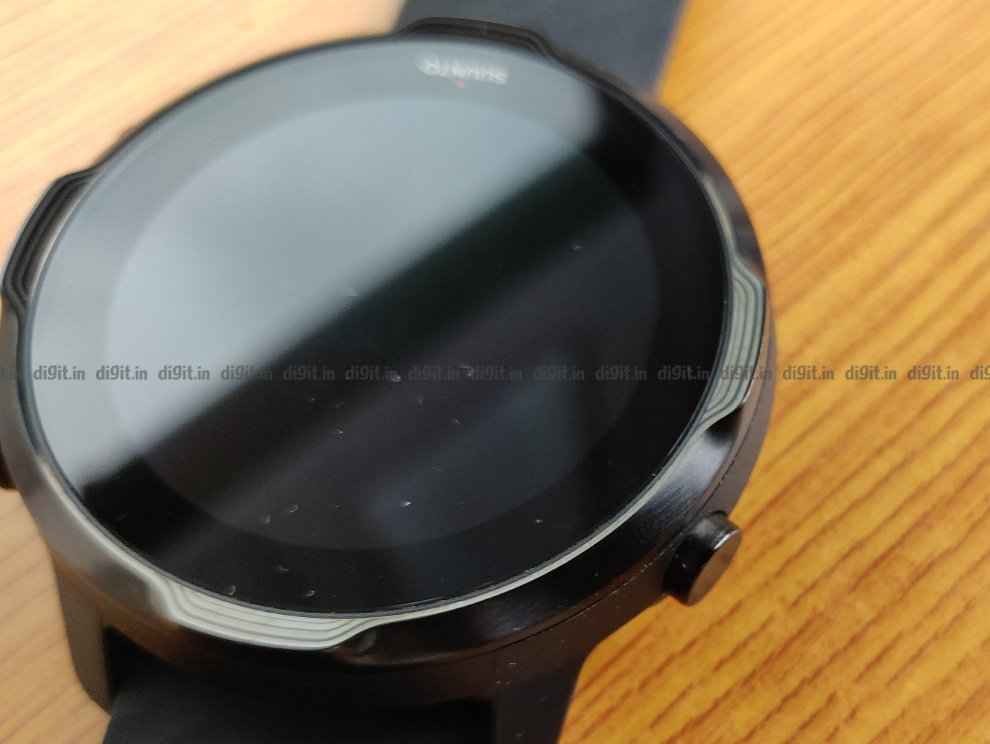
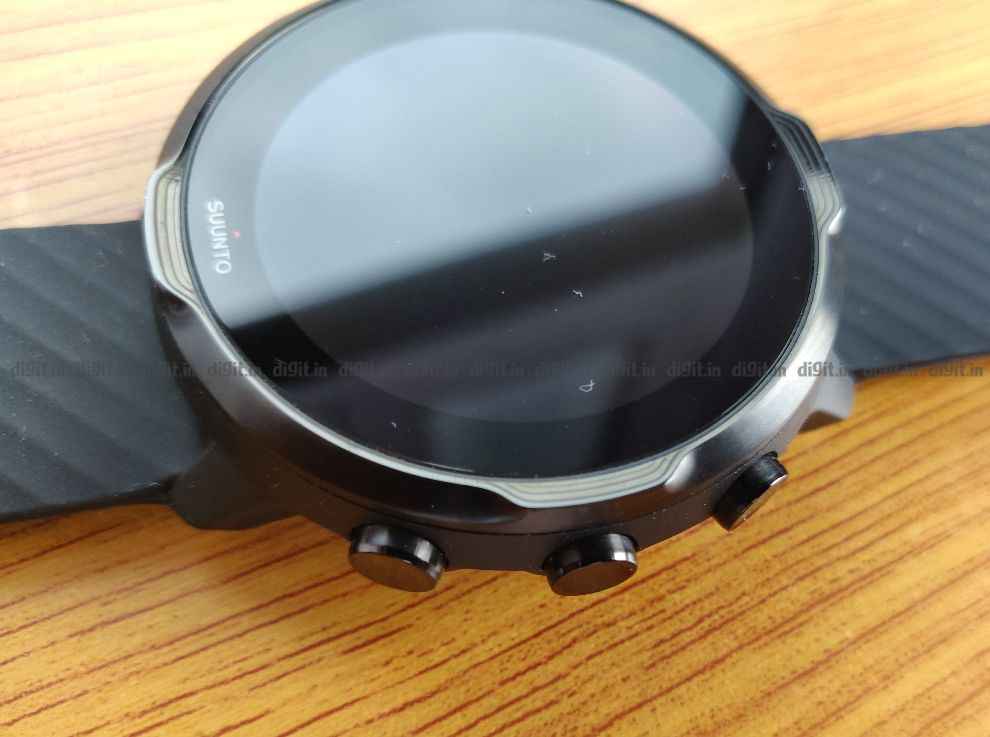
Suunto has been making sports watches for quite a long time now. So users can expect the Suunto 7 to offer a host of activity tracking options and thankfully the wearable does not disappoint. The watch offers a whole host of activity tracking options that range from walking and cycling to hiking, pool, kettlebell, roller skating and more.
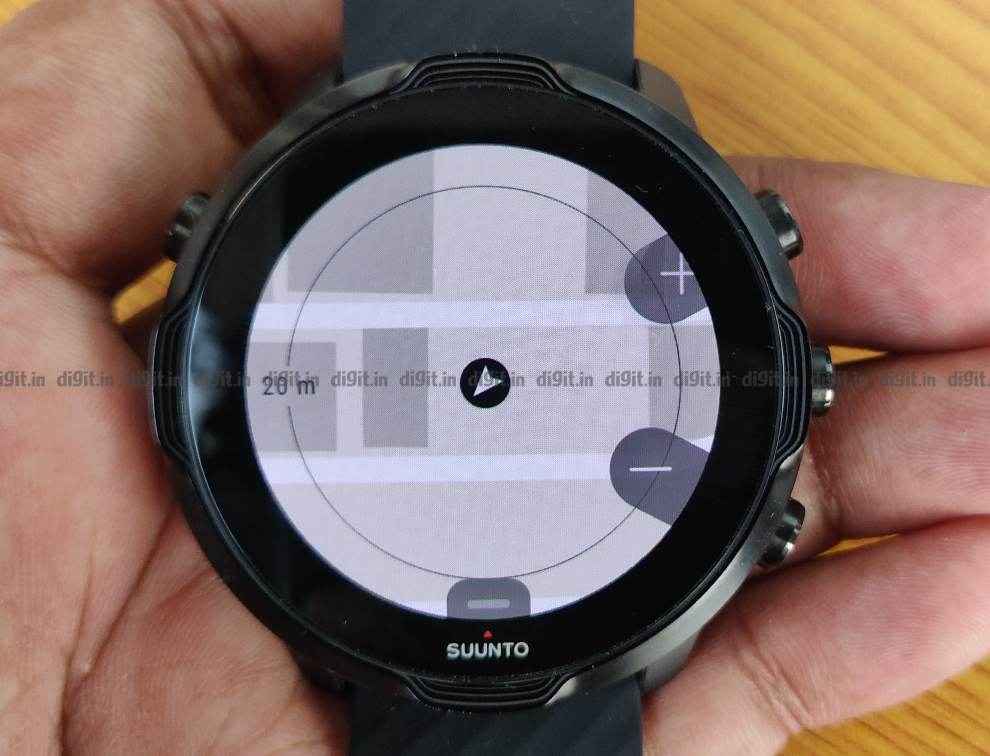
I usually have a system wherein I do a set of Seven Minute Workouts to gauge the effectiveness of any wearable against its competitors. However, due to a very annoying and persistent pain on my wrist, I was unable to do just that. Thankfully, my office has opened up so I could use my commute as a benchmark.
My commute is pretty straightforward. It sees me mostly walking about during the commuting hours, and sitting in front of my computer for the rest of the time. As such, the number of steps I take during office days is usually around the same ballpark. Thankfully, the step counter was on-point at around 5000 steps. Besides steps, the wearable also tracks calories and
Suunto 7: AppSetting up the Suunto 7 requires the user to install two apps on their smartphone. The WearOS app and the Suunto app. While it is mildly inconvenient, it’s not that bad. The WearOS apps handle smartwatch focused features such as apps, watch faces, notifications, tilt-to-wake and more. The Suunto app is where users will get access to metrics related to activities.
The WearOS is pretty straight forward and aside from the initial setup, I barely used it. As mentioned earlier, it is also how users will be able to switch watch faces. I personally loved the ‘Heat Map’ watch face as it showed an overview of your local area with frequently travelled activity highlighted.
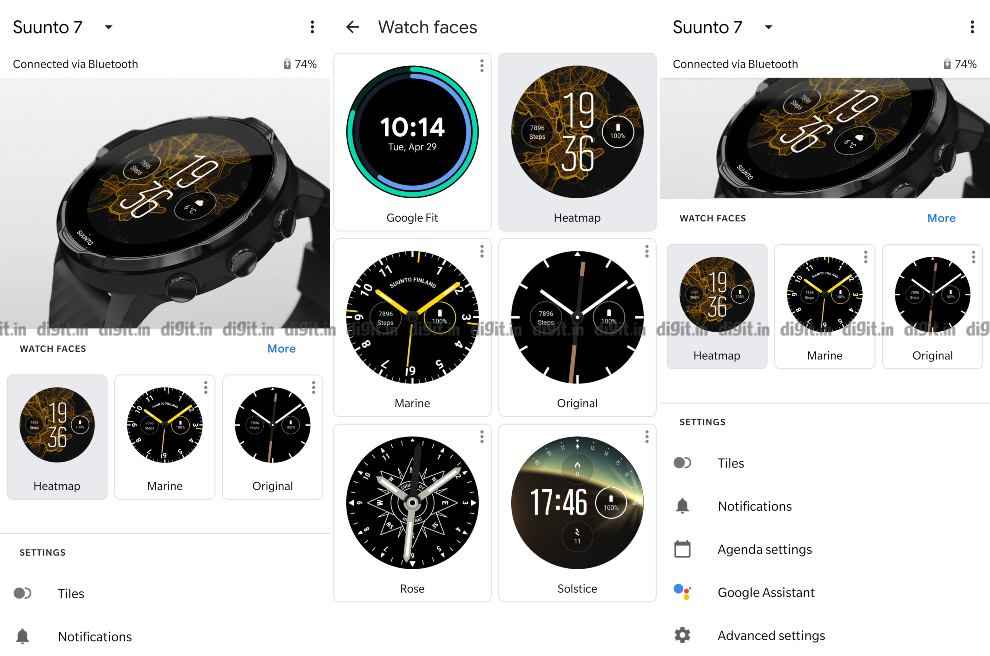
The Suunto app is more geared towards fitness and as such, will most likely be the app that users will access more of. The app is pretty straightforward and gives users access to information in the form of cards.
The first thing users will see when they open the app is a round-up of their activities. This includes the total duration of their activity as well as a break-up of their activities throughout the month. Swiping through lets users access their weekly form, fatigue and fitness levels.
Tapping on any one of the activity cards gives you the detailed information. Besides the usual slew of information like duration, distance, average speed and so forth. Users can also access information such as ascent, Training Stress Score (based on intensity and duration), pace, cadence, and more.
One of the most interesting features of the app is the fact that users can replay their activity and route. This allows them to see their speed, altitude and heart rate across different sections. This can be a handy tool when planning a route as it will allow users to fine-tune routes based on their intensity levels.
Swiping right from the main tab gives users access to the calendar, activity trends and the map.
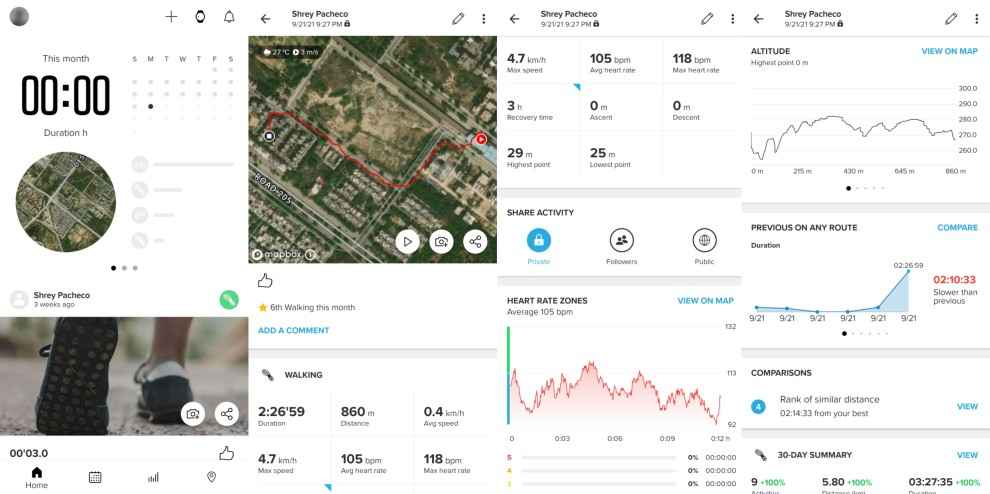
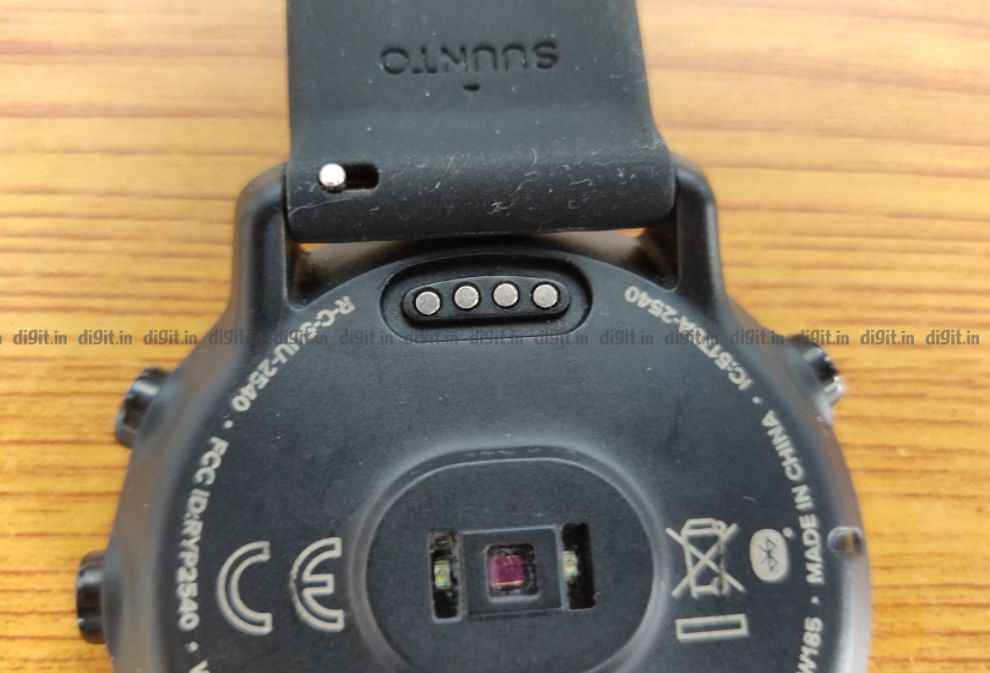
The Suunto 7 offers a battery life of just about a day, which can be pushed to a day-and-a-half with average use. This is on par with most other smartwatches such as the Apple Watch Series 6 (review). However, it does pale in comparison to dedicated fitness wearables such as those from Garmin.
This can be a bit of an issue for anyone looking to use the devices for something like hiking/camping. Plug points could be few and far between, and pretty much requires the use of a power bank.
Suunto 7: VerdictThe Suunto 7 is a pretty unique offering. Its WearOS base gives users the flexibility to access major apps that they can install on their wearable. Along with that, the legacy and expertise of Suunto give the watch a top-notch build that can rival any rugged watch in the market. As such, the Suunto 7 is arguably the most rugged device that can call itself a proper smartwatch.
However, not everything is perfect. The UI in the Suunto 7 is confusing at least. The relatively poor battery life is also a cause for concern for those planning to wear it for camping or long hikes.
The UI concerns as well as relatively poor battery life make it difficult to recommend to new users looking for a rugged new wearable. However, those who require ruggedness and don’t really need smart features might be better off with something like the Garmin Forerunner 55. Similarly, those looking for a fitness-centric device without much ruggedness might consider something like the Apple Watch SE or the Samsung Galaxy Watch 4 (review), both of which are considerably more affordable.
The Suunto 7 has the unique position of being one of the only smartwatches to feature this level of ruggedness. As such, it doesn’t really have much in terms of direct competition. However, if Suunto can streamline the UI and improve battery life, it has the potential to be among the best.
from Wearable Devices Reviews https://ift.tt/3pgALN7
High Volatility in the cryptocurrency market: Bitcoin falls to 54,000
Bitcoin (CRYPTO: BTC) was created by Satoshi Nakamoto and its ledger started on January 3, 2009. Since its inception, it has become the most valuable and popular digital asset in the world.
2021 has been a roller coaster ride for the cryptocurrency market. Crypto leader Bitcoin touched an all-time high of $ 65,000 (roughly ₹ 47.7 lakhs) in April 2021. After touching its all-time high, Bitcoin prices corrected by more than 50 percent in May 2021.
Bitcoin prices on Thursday re-claimed the $ 55,000-levels (roughly ₹ 41.3 lakhs). The next day it dropped to $ 54,000 (roughly ₹ 40.6 lakhs). Bitcoin prices are just $ 10,000 (roughly ₹ 7.51 lakhs) away from their all-time high.
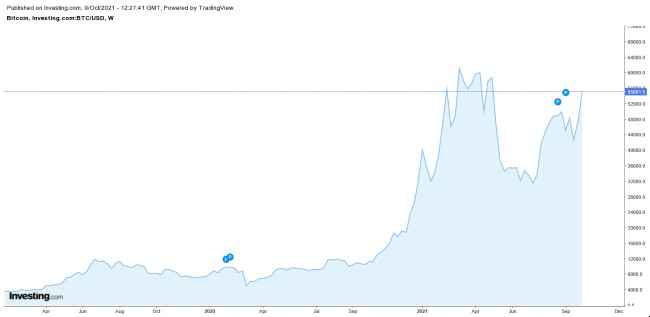
Analysts do not have a definite answer behind the bull run of Bitcoin prices. Several media reports highlight that the US Securities and Exchange Commission (SEC) might approve bitcoin exchange-traded products (ETF) in the next few weeks. Some analysts believe that this move will further ignite the demand for cryptocurrency.
US Bank, the fifth-largest bank in the USA announced it launched cryptocurrency custody services for institutional investors. The bank has appointed New York Digital Investment Group (NYDIG) as a sub-custodian to manage the private keys.
“Our fund and institutional custody clients have accelerated their plans to offer cryptocurrency and, in response, we made it a priority to accelerate our ability to offer custody services,” Gunjan Kedia, vice-chair of U.S. Bank Wealth Management and Investment Services, said in a press statement.
Cryptocurrencies are being recognised globallyIn September 2021, we reported that El Salvador became the first country to declare Bitcoin as a legal tender. While speaking at the Bitcoin event “The B Word", Tesla CEO Elon Musk said that he owns Bitcoin, Dogecoin and Ethereum. 'Outside of Tesla and SpaceX stock, it's my largest holding,' Tesla CEO said.

A Bloomberg report predicts that the Bitcoin prices can scale upto $ 100,000 by the end of 2021 (roughly ₹ 75.1 lakhs).
At the time of writing this article, Bitcoin prices were trading at $ 55,100 (roughly ₹ 41.4 lakhs).
from Crypto News https://ift.tt/3pfKWBN
Delete these three malicious apps from your smartphone as per Google
A recent review undertaken by Google led to the tech giant banning as many as 150 apps from the PlayStore recently. Now, Google has identified three additional apps that steal vital data from consumers by tricking them. These three apps are "Magic Photo Lab - Photo Editor”, "Blender Photo Editor-Easy Photo Background Editor", and "Pix Photo Motion Edit 2021".
 What do malicious apps on Google PlayStore do?
What do malicious apps on Google PlayStore do?
Google categorises apps that steal data from consumers as malicious. These apps can trick you into sharing log-in credentials, thereby stealing other information through the same. Some apps also trick you into sharing your bank account details so that the creators can siphon off money from time to time.
If you have happened to download any of the three apps mentioned above, then you should delete them from your smartphone immediately. This is because even though Google has banned them from the PlayStore, they still function normally on your smartphone and can steal your data.

A great way to protect yourself and minimise the chances of downloading such apps is by sticking to only those apps that are well-known. For instance, you can have a look at these top 10 photo editing apps that are known not just for offering good results, but also for being safe.
When considering a new app to download, have a look at the number of downloads and the kinds of comments that are there in the review section. Both can help you gauge the safety of the app before you end up housing it in your phone.
Also Read: Google will auto-enroll users in two-step verification by end of 2021
Video Source: Android
from Crypto News https://ift.tt/3n8ySPP
Airtel Xstream, JioFiber, BSNL offer a range of Monthly broadband plans under Rs 1500, check details
JioFiber broadband plan starts for as low as Rs399. This offers unlimited internet usage at speeds of 30Mbps with free voice calls. BSNL Bharat Fiber and AirtelXstream both have termed their plans as Fibre Basic and Basic respectively. BSNL Bharat Fibre offers data usage at a speed of 30Mbps but it is capped at 3300GB’s usage, post that the speeds will come down to 2Mbps and free voice calls to all networks. AirtelXstream here along with unlimited calls offers a better proposal of a slightly high-speed data rate of 40Mbps, also subscriptions for Wynk Music and Shaw academy.
AirtelXstream Rs799 Vs JioFiber Rs699 Vs BSNL Bharat Fibre Rs799
AirtelXstream Standard Plan offers up to 100Mbps internet speeds with unlimited data and calls along with subscriptions to Wynk music and Shaw Academy. The JioFiber Rs699 plan offers true 100Mbps internet speeds and unlimited calls. BSNL Bharat Fibre Value plan offers 3300GB of data at up to 100Mbps speed post which the data speed will be reduced to 2Mbps. Additionally, BSNL has an option cheaper than JioFiber Rs699, BSNL Bharat Fibre Basic Plus plan at Rs599 which offers speeds of up to 60Mbps up to 3300GB and then capping down to 2Mbps.
AirtelXstream Rs999 Vs JioFiber Rs999 Vs BSNL Bharat Fibre Rs999
AirtelXstream Entertainment Plan offers up to 200Mbps internet speeds with unlimited data and calls. The name of the plan is so as along with Wynk Music they offer Amazon Prime and Disney+Hotstar Super subscriptions. The JioFiber Rs999 plan offers true 150Mbps internet speeds and unlimited calls. Along with Jio Saavn also on offer are subscriptions to 14 OTT platforms like Amazon Prime, Disney+Hotstar, Voot Select to name a few except Netflix. BSNL Bharat Fibre Premium plan offers 3300GB of data at up to 200Mbps speed post which the data speed will be reduced to 2Mbps. However, BSNL offers just 1 OTT subscription of Disney+Hotstar Premium.
JioFiber Rs1499 Vs AirtelXstream Rs1499 Vs BSNL Bharat Fibre Rs1499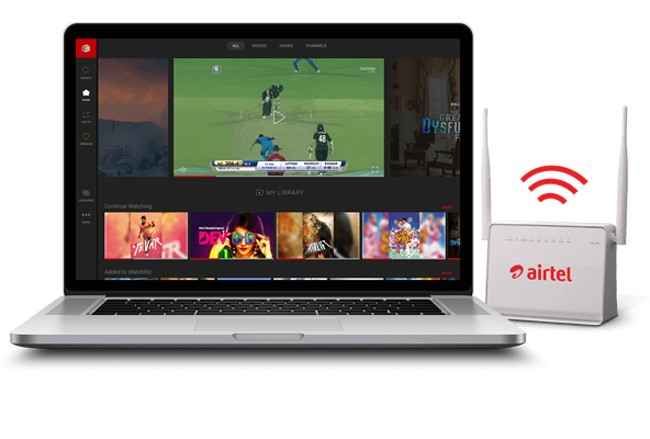
The best offering in this price bracket is the JioFiber Rs1499 plan; it offers true 300Mbps internet speeds and unlimited calls. Along with Jio Saavn also on offer are subscriptions for 15 OTT platforms like Netflix Basic, Amazon Prime, Disney+Hotstar, SunNext to name a few. AirtelXstream Professional Plan offers up to 300Mbps internet speeds with unlimited data and calls. Along with Wynk Music, the plan offers Amazon Prime and Disney+Hotstar Super subscriptions. BSNL Bharat Fibre Ultra plan offers 4000GB of data at up to 300Mbps speed post which the data speed will be reduced to 4Mbps. BSNL still offers just 1 OTT subscription of Disney+Hotstar Premium. However, It needs to be mentioned that BSNL has one extra offering under Rs.1500 the Bharat Fibre Premium Plus Rs1247 Plan which does not offer OTT subscription but offers 3300 GB of data at up to 200Mbps speed post which the data speed will be reduced to 15Mbps.
from Crypto News https://ift.tt/3vrSJgB
Google Chat will now prevent data leaks with its new features
With many employees using Google Chat and other Google products to carry out their work, Google is now trying to ensure that it can prevent data leaks by introducing new features through Google Chat. To this effect, Google is working on new Data Loss Prevention (DLP) rules and policies for Admins in Google Chat. At the moment, these new features are in the Beta stage, and you can sign up to be a part of the Beta pool if you want to check it out.

These new Data Loss Prevention (DLP) rules being tested by Google should be quite valuable for people who share sensitive content on the platform with peers. The features should help prevent data leaks, ensuring that confidential organisational data remains safe at all times.
Once the features are rolled out, the admin will be given access to a set of rules and settings. These can then be enabled or even customised to fit the specific requirements of the group. After the settings are enabled, Google will scan all messages and content shared in the group to understand whether the information being shared is sensitive. Based on that, it will protect the information being shared.

What’s interesting is that these rules won’t just be applied to Google Chat, but also to Google Drive and Chrome. If someone tries to share a sensitive file on Google Drive, the file itself will be blocked and the admin will be notified of the same.
Also Read: Google will auto-enrol users in two-step verification by end of 2021
from Crypto News https://ift.tt/3lR1s9c
flipkart
Edit videos on your mobile phone using the YouTube Create App
YouTube has introduced its new mobile app called ‘YouTube Create’. This app offers an easy way for creators to edit their videos right from ...

- September 2023 (83)
- August 2023 (126)
- July 2023 (113)
- June 2023 (102)
- May 2023 (162)
- April 2023 (160)
- March 2023 (148)
- February 2023 (136)
- January 2023 (173)
- December 2022 (163)
- November 2022 (163)
- October 2022 (181)
- September 2022 (178)
- August 2022 (174)
- July 2022 (136)
- June 2022 (125)
- May 2022 (146)
- April 2022 (130)
- March 2022 (143)
- February 2022 (132)
- January 2022 (145)
- December 2021 (157)
- November 2021 (239)
- October 2021 (269)
- September 2021 (270)
- August 2021 (212)
- July 2021 (252)
- June 2021 (225)
- May 2021 (184)
- April 2021 (181)
- March 2021 (343)
- February 2021 (299)
- January 2021 (320)
- December 2020 (334)
- November 2020 (305)
- October 2020 (318)
- September 2020 (340)
- August 2020 (347)
- July 2020 (337)
- June 2020 (310)
- May 2020 (308)
- April 2020 (418)
- March 2020 (316)
- February 2020 (282)
- January 2020 (329)
- December 2019 (323)
- November 2019 (393)
- October 2019 (403)
- September 2019 (386)
- August 2019 (454)
- July 2019 (579)
- June 2019 (509)
- May 2019 (697)
- April 2019 (725)
- March 2019 (746)
- February 2019 (702)
- January 2019 (932)
- December 2018 (758)
- November 2018 (729)
- October 2018 (835)
- September 2018 (838)
- August 2018 (548)
- March 2018 (24)
-
PlayStation Essential Picks and Xbox Store sales are now live. A total of over 500 games are available with up to 85 percent discounts. Game...
-
According to Nintendo, you won't need to use motion controls or physical gestures when playing Pokemon Let's Go Pikachu and Eevee in...
-
FIFA 20, Star Wars Jedi Fallen Order, Need for Speed 2019 and the rest of EA's lineup won't be on Amazon India exclusively, and will...